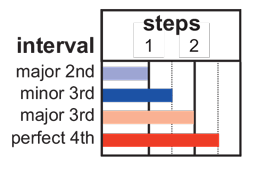Chord Tree

Chord Tree Intervals
Knowing the notes that make up chords is one of the most important music theory skills a musician can have. However, even more important is knowing the musical intervals that make up those chords. This interactive diagram shows the intervals that make up each chord and the relationship chords have to each other.
The Tree begins (as all trees do) with a note in the root position. From there, the Chord Tree branches out in different directions. The interval between the root and second note of a chord determines whether the chord is minor, major, or suspended. The intervals that follow build out the chord and determine its final name and chord type.
The scale degree of the notes that make up each chord are indicated by the labels above and below the diagram. The legend at right shows the colors associated with the intervals that make up the chords.
A chord's name is indicated near the last note of the chord. For instance, if C were the root and we followed the lowest branch on the diagram, we would come across the notes F and G. The chord that has these notes is a Csus. If we were to go the end of the branch to add the B< to the chord, it would then be called a Cdom7sus (aka C7sus).
Instructions
Mouse over or click any of the key-note buttons below the main diagram to select a root note. Follow any of the branches to see the notes and intervals that make up the given chord. If the diagram does not change immediately, your computer may be taking time to load the data. Be patient.
